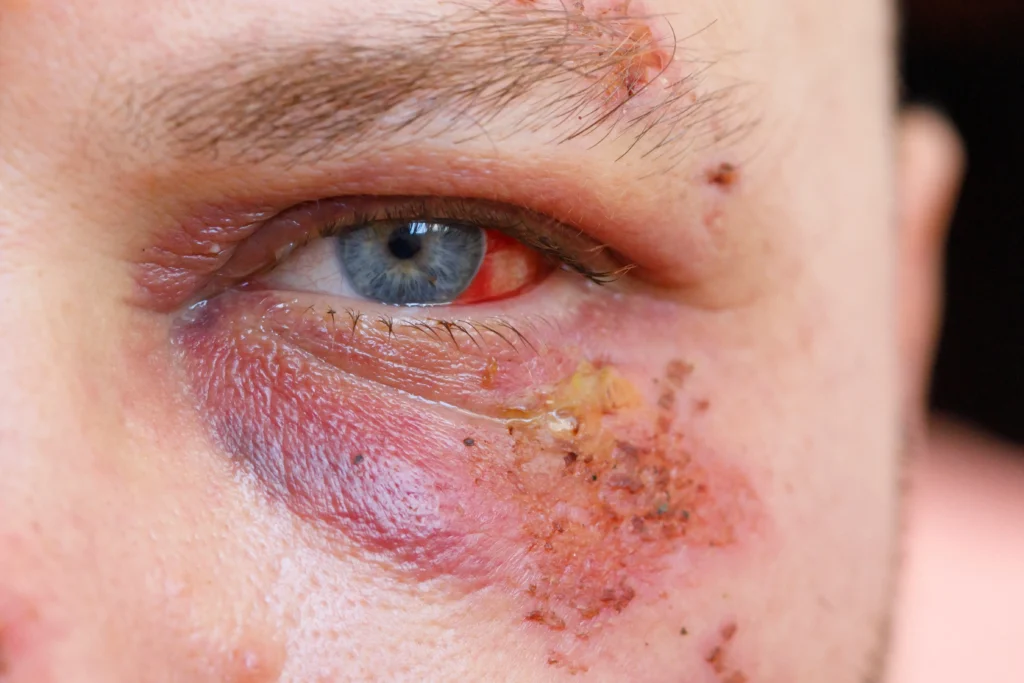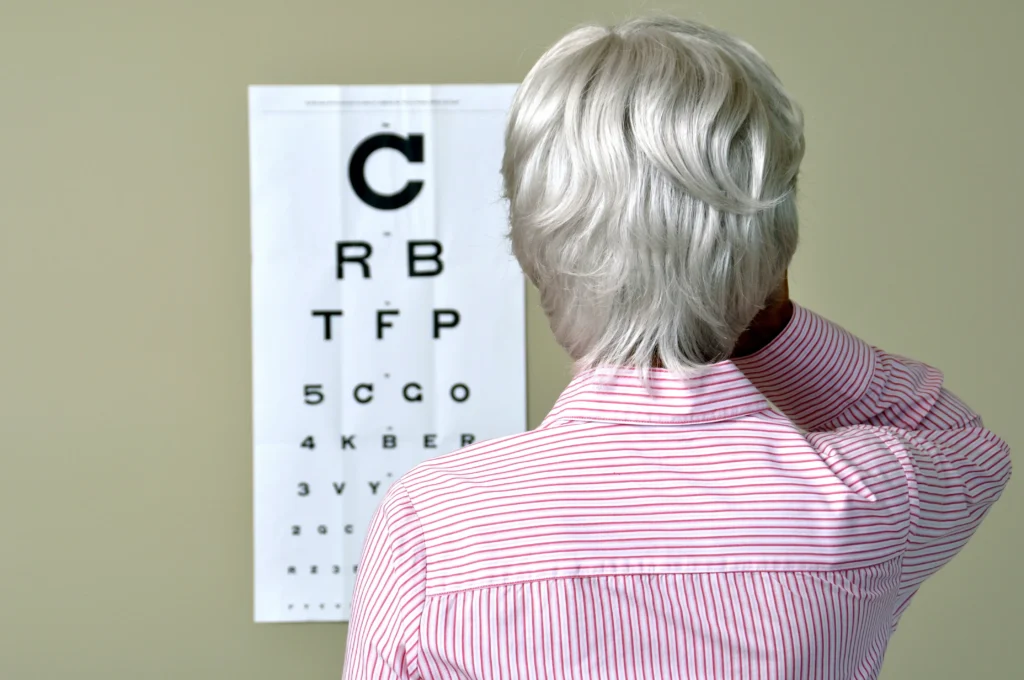Vision loss represents one of the health concerns facing humanity. Sight is one of our body’s important senses, through which we can discover the multiple worlds around us. It makes it easier for us to move, communicate, learn, work, and avoid imminent dangers.
To preserve the advantages that our sense of sight grants us, we must identify the types of risks that can affect the eye, strip it of its effectiveness and role, and ultimately lead to vision loss, as well as work to prevent those risks.
——- Ad ——-
——- Ad ——-
Causes of Vision Loss
The causes of vision loss are divided into 3 categories:
Organic Diseases
Among the non-infectious organic diseases that can lead to vision loss are the following:
• Refractive Errors: These vary between nearsightedness, farsightedness, and astigmatism, which limit the clarity of vision. Neglecting their correction may lead to vision loss or impairment. There are 671 million people in the world who suffer from total or partial vision loss or impairment due to refractive errors.
• Cataracts: The leading cause of blindness in the world, it is a condition in which the eye’s lens becomes cloudy or foggy, and with it, the clarity of vision gradually declines. Approximately 100 million individuals worldwide are blind or have impaired vision due to cataracts.
• Diabetic Retinopathy: A condition resulting from diabetes that damages the blood vessels in the retina. If the affected eye is not treated promptly, it will lose its ability to see. Statistics indicate there are 4 million people on Earth suffering from vision impairment or loss due to diabetic retinopathy.
• Glaucoma: An eye disorder that damages the optic nerve tissue due to high eye pressure. Glaucoma is currently responsible for about 8 million individuals suffering from vision loss or impairment.
• Age-related Macular Degeneration (AMD): Affects the center of the retina, causing a loss of the central vision necessary for seeing fine details. In fact, there are 8 million people in the world who have lost their sight or part of it due to AMD.
• Stroke: A lack of blood flow to the parts of the brain responsible for vision may occur, resulting in total or partial vision loss.
Infectious Diseases
Infectious diseases may cause a person to suffer vision loss, including the following:
• Toxoplasmosis: A disease in which one of its forms is Ocular toxoplasmosis. It leads to inflammation of the retina in the back of the eye and may end in blindness if not treated. Toxoplasmosis occurs when the human body contracts a parasite called Toxoplasma gondii, which is transmitted by drinking contaminated water, eating undercooked meat containing this parasite, or touching the feces of infected cats.
• Rubella (German Measles): When a mother is infected with rubella in the first three months of pregnancy, it leads to Congenital Rubella Syndrome (CRS). This syndrome is a major cause of blindness, deafness, heart disease, and mental retardation. It is estimated that about 100,000 children are affected by this syndrome annually worldwide.
• Shingles (Herpes Zoster): A viral infection that forms a painful rash and may lead to inflammation of the optic nerve. It can ultimately result in total vision loss.
• Syphilis: Caused by a bacterium known as Treponema pallidum, it is a sexually transmitted disease. The disease affects various body organs, including the eye, causing changes in vision that may extend to vision loss.
• Histoplasmosis: A fungal infection caused by a fungus called Histoplasma capsulatum, transmitted to the human body by inhaling spores present in the air and contaminated soil. This fungus can lead to tissue damage and blindness, especially for those with compromised immunity.
Injuries
You must protect your eyes from injuries, as they can expose the eyes to impairment and even vision loss. Examples of injuries include:
- Exposure to toxins
- Fireworks and firecrackers
- Falls and collisions
- Blows
- Chemical burns
- Excessive and direct exposure to ultraviolet rays
- Looking directly at other bright lights such as welding

——- Ad ——-
——- Ad ——-
Statistics on Vision Loss Cases
In 2020, 1.1 billion cases of people suffering from vision problems, including visual impairment or blindness, were recorded. The cases were distributed as follows:
- 43 million people worldwide suffer from blindness, with a prevalence rate of 0.5% of the total global population.
- 295 million individuals suffer from moderate to severe visual impairment, with a prevalence rate of 3.7% of the total global population.
- 258 million people in the world suffer from mild visual impairment, with a prevalence rate of 3.3% of the global population.
- 510 million people around the world have near vision problems, with a prevalence rate of 6.5% of the total world population.
These numbers are expected to increase in the near future. According to a report by the International Agency for the Prevention of Blindness (IAPB), it is likely that cases of vision loss will rise to affect an additional 600 million people by the year 2050, an increase of 55%. The agency attributes this problem to two main factors: aging and a change in lifestyle that tends towards inactivity and unhealthy nutrition.
Habits Harmful to the Eye
Besides the diseases and injuries that can affect the sense of sight, there are wrong habits an individual may practice that threaten the safety of their vision. These habits include:
1. Smoking: The eye is one of the body parts affected by smoking. Smoking increases the chance of the eye developing several diseases like macular degeneration and cataracts, and smoking can also harm the optic nerve.
2. Staying up late and lack of sleep: There is no doubt that poor sleep negatively affects eye health. When you don’t get enough or high-quality sleep, your eyes do not get enough time to rest and rejuvenate. Individuals who lack good sleep are 50% more likely to develop dry eye compared to others who get good sleep.
3. Poor nutrition: If you do not include vegetables and fruits in your daily diet, you deprive yourself of important nutrients for eye health, such as vitamin A, vitamin C, and others. Also, eating fish benefits your eyes in the long run as it contains omega-3, which protects you from high eye pressure.
4. Rubbing the eyes: The skin around the eyes is very sensitive. Therefore, rubbing the eyes can lead to the rupture of small blood vessels under the skin, causing dark circles and puffiness. Frequent eye rubbing over a long period has been linked to a condition called Keratoconus. This condition results in the thinning of the cornea and the loss of its natural shape, which ultimately leads to blurred vision that may be difficult to correct completely with contact lenses or glasses.
5. Staring at electronic screens for long periods: Electronic screens emit a light known as blue light, which is part of the visible light spectrum and has a short wavelength, meaning it carries relatively high energy. Prolonged staring at different screens that carry that light can cause dry eyes, blurred vision, and tearing. It can also lead to the disruption of the natural sleep cycle and reduce the body’s production of the sleep hormone “melatonin,” as the emitted light promotes a feeling of alertness and wakefulness.
Preventive Measures to Protect Vision
Because an ounce of prevention is worth a pound of cure, let’s consider the following set of preventive measures aimed at protecting the eye from numerous diseases and the risk of vision loss:
1. Periodic eye examination: Regular eye exams contribute to the early detection of vision problems, eye diseases, and general health issues even before you feel their presence. This means that some diseases like glaucoma may not be accompanied by symptoms warning of a problem until after permanent vision loss has occurred.
2. Wear sunglasses: Not wearing sunglasses exposes your eyes to the sun’s rays, such as ultraviolet and high-energy visible rays, which have several harmful effects on the eye, such as aging of the eyes and the surrounding skin. Excessive sun exposure can also lead to sunburn on the front surface of the eye, in addition to causing dry eyes and general irritation.
3. Reduce the brightness and duration of your use of digital devices: Chronic use of a specific electronic device leads to what is known as “digital eye strain,” a condition that brings with it headaches, blurred vision, dry eyes, and redness. Therefore, you should reduce the brightness of your electronic device and decrease the time you spend using it.
4. Rest your eyes: On the other hand, take regular breaks for your eyes by moving them in all directions, applying the 20-20-20 rule: every 20 minutes, look at something 20 feet (6 meters) away for 20 seconds. This technique helps you relieve eye strain.
5. Use protective equipment: It is important to use specialized safety glasses to protect the eyes before performing hazardous activities such as welding, drilling, cleaning, and swimming, and the chemical substances, flying dust, and fragments that may result from them and settle inside the eye.
6. Drink enough water: Be sure to drink the necessary amount of water daily, which is two liters or 8 cups, while following a diet rich in sodium, to enable the eye to produce a sufficient amount of tears to lubricate it and protect it from dryness.
7. Stay away from dangerous situations: Such as violent fights, stone-throwing, and setting off fireworks, which can cause an injury that harms the eye, or even lead to vision loss in one or both eyes. Therefore, you must not approach or get involved in such dangerous situations.
Conclusion
In the end, it is essential that we realize the importance of the eye in our bodies and pay attention to the negative habits and various dangers that threaten it, as a prelude to taking approved preventive measures against these dangers which could lead to vision deterioration or complete vision loss.
○ Share the article:
References
(1) Prevalence of eye signs in congenital rubella syndrome in South India: A role for population screening. National Library of Medicine
(2) 7 Bad Habits That Harm Your Eyes and Vision, Washington Eye Physicians & Surgeons
(3) Sleep and Dry Eye Disease – What’s the Link?, Assil Gaur Eye Institute
(4) Digital Devices and Your Eyes, American Academy of Ophthalmology
(5) What Is Toxoplasmosis?, American Academy of Ophthalmology


